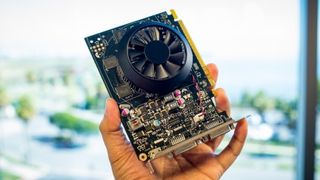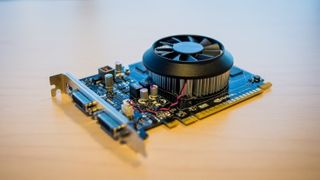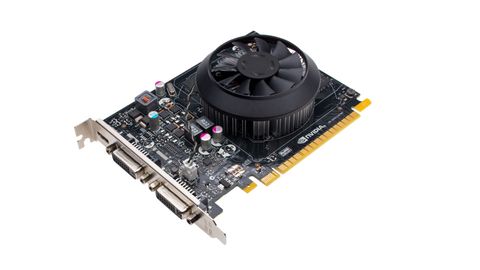TechRadar Verdict
As a low-cost, low-power graphics card, the 750 Ti is currently a very good option for anyone building a value gaming PC, especially if it's a Steam Machine.
Pros
- +
Small form factor
- +
Quiet
- +
No additional power connectors needed
- +
Consumes very little wattage
Cons
- -
No SLI option
- -
No game bundle
Why you can trust TechRadar
Update: We've added pictures of the 750 Ti to show its diminutive size
Nvidia and AMD have been waging a graphics war that's getting bloodier than ever, thanks to the release of Nvidia's 700-series and AMD's R7 and R9-series video cards.
The green team's newest edition to the market is the 750 Ti, which provides gamers with an inexpensive 1080p gaming video card.
Nvidia's small-sized 750 Ti runs only US$149 (or £114, AU$219), half the price of the GTX 760, and just $20 more than AMD's R7 260X, if you account for the 260X's recent price cut.
While the 260X is a rebadged Radeon HD 7790, Nvidia's 750 Ti features a brand new GPU architecture called Maxwell.
In the past Nvidia has released new architectures from the top down, meaning they would typically release a high-end video card like the Titan and then slowly release lower-end GPUs with the new architecture.

It's definitely a savvy move for Nvidia to refresh their low-end offerings first; at $150 the 750 Ti is an impulse buy compared to upcoming Maxwell refreshed Titan Black.
Like other 700-Series cards, the 750 Ti supports G-Sync, a new technology from Nvidia that allows GeForce video cards to play games without refresh rate induced stutter or screen tearing. A G-Sync capable monitor is required, as well as a GTX 650 Ti Boost video card or higher.

I haven't tested G-Sync out myself, but I'm keen to see how it can smooth out the play experience with the 750 Ti and other compatible Nvidia cards. Another Nvidia-exclusive feature the 750 Ti sports is Nvidia Game Streaming, which allows users to stream games from their PC to an Nvidia Shield.
Little card, big numbers
Unwrapping the 750 Ti, I was pleasantly shocked by its size. The card measures just 5.7" (14.5cm) and features a single-slot design. Even more impressive is that the 750 Ti doesn't require any additional power connectors.
AMD's R7 260X, however, requires one 6-pin power connector and it's also an inch (2.5 cm) longer. Lastly, the 750 Ti supports up to three displays and features one Mini-HDMI port and two Dual-Link DVI ports.

The 750 Ti is a power-efficient video card that consumes a mere 60W. In contrast, AMD's R7 260X eats up almost double the wattage with its 115W TDP. Nvidia's PSU requirement for the 750 Ti is also low at just 300W, so you won't need a beefy 500W or 750W beast to power this mini GPU. That, combined with its small size, makes it an easy upgrade for a wide swath of systems.
When it comes to specs this entry-level 700-Series card doesn't disappoint. The card features 512 CUDA cores, a base clock of 1020MHz, and a boost clock of 1085MHz.
The 750 Ti comes with 2GB of GDDR5 video RAM clocked at 5400MHz, too. It's worth mentioning a non-Ti version will come soon and sport 1GB of RAM and retail for $119/£90. If you're going to run multiple monitors I'd push you toward this 2GB Ti version, as you'll have more video RAM bandwidth for doing things across your displays.
Overclocking
I overclocked the 750 Ti by modestly increasing its boost clock to 1169MHz, using EVGA's Precision X overclocking tool.
Doing so created no detectable stability issues, and provided a performance increase of about 5% across all games, with the exception of Batman: Arkham Origins which only received a 3% boost in performance. Noise was no problem when I overclocked the card, and it wasn't noticeably louder than when it was stock clocked.

To benchmark the 750 Ti's performance I d it off against AMD's R7 260X and a Sapphire HD 7790 OC. Both AMD cards sell for $120-$130, so they're less expensive than the 750 Ti, but not by much. The 750 Ti won every benchmark against the AMD cards, making it the clear winner in terms of raw performance.
I also tested the 750 Ti against last year's GTX 650 Ti. When averaging all the benchmarks together, Nvidia's 750 Ti is 22% faster than the 600 series card. The 750 Ti's performance is impressive, as the 650 Ti almost consumes twice the amount of power with its 110W TDP. Nvidia's 650 Ti card also features a two-slot design, so the 750 Ti is a slimmer, faster, and more powerful GPU overall.
Benchmarks
All benchmarks were run on the high settings at 1920x1080, (except when otherwise noted) with 4X FXAA enabled. Our test bed consisted of an Intel Core i7-2700K at stock speeds on a Gigabyte Z68X-UD7-B3 board with 8GB of DDR3/1600 RAM, a 128GB SanDisk Extreme II SSD drive, and a 750W Cooler Master power supply.
DirectX 11 gaming performance: Frames per second: higher is better
Sleeping Dogs:
750 Ti: 50.1
- R7 260X: 47.7
- Radeon HD 7790: 47.6
- 650 Ti 1GB: 42.0
- 750 Ti Overclocked to 1169MHz: 52.6
Tomb Raider (2013):
TressFX disabled
- 750 Ti: 65.9
- R7 260X: 59.8
- Radeon HD 7790: 60.4
- 650 Ti 1GB: 57.2
- 750 Ti Overclocked to 1169MHz: 68.7
Metro Last Light:
Settings used: SSAA Enabled, PhysX Disabled
- 750 Ti: 22
- R7 260X: 18.46
- Radeon HD 7790: 18.75
- 650 Ti 1GB: 16.43
- 750 Ti Overclocked to 1169MHz: 23
Batman: Arkham Origins:
Settings used: MSAA 4X, Geometry DX11 Enhanced, Dynamic Shadows DX11 Enhanced, D.O.F. DX11 Enhanced, PhysX Disabled
- 750 Ti: 59
- R7 260X: N/A
- Radeon HD 7790: N/A
- 650 Ti 1GB: 53
- 750 Ti Overclocked to 1169MHz: 61
DirectX 11 tessellation performance: Frames per second: higher is better
3DMark Fire Strike (normal)
- 750 Ti: 3845
- R7 260X: 3713
- Radeon HD 7790: 3664
- 650 Ti 1GB: 3018
- 750 Ti Overclocked to 1169MHz: 4017
Heaven 4.0:
Settings used: API: DirectX 11, Quality: Ultra, Tessellation: Extreme, AA X4
- 750 Ti: 23.8
- R7 260X: 19.7
- Radeon HD 7790: 19.7
- 650 Ti 1GB: 17.9
- 750 Ti Overclocked to 1169MHz: 24.4
Catzilla (576p)
- 750 Ti: 9557
- R7 260X: 9002
- Radeon HD 7790: 8889
- 650 Ti 1GB: 8173
- 750 Ti Overclocked to 1169MHz: 10047
We liked
At $150 the 750 Ti offers impressive bang for buck performance. I saw the card effortlessly handle games at 1080p with high settings. Every game I used for benchmarking, except the punishing Metro: Last Light, naturally, ran at a silky smooth 50-60 FPS.
I'm really impressed by its miniscule power consumption, no additional power connectors required. I also appreciate the sleek 5.7" single-slot design, which makes this card great for living room friendly small-form-factor PCs. That's a wise design choice with the Steam Box revolution right around corner.
We disliked
There's not much to moan about with the 750 Ti, however, if you're looking for a $150 video card that supports dual-GPU capabilities, keep looking. The 750 Ti doesn't support SLI, so if you want a budget card that will let you add a second GPU down the line, I'd recommend a trip to AMD country for R7 260X.
Also, the R7 260X currently comes bundled with two games, and the 750 Ti does not, at least as of this writing. This is by no means a deal breaker, but getting to pick between Thief (coming out February 25th), Deus Ex: Human Revolution, Hitman Absolution, Dirt 3, and Sleeping Dogs is something to consider, especially if that lack of SLI support is bumming you out.
Final verdict
Nvidia's really taken it to AMD with the 750 Ti. It consumes less power and outperforms both the R7 260X and HD 7790 by an average of 11% in both gaming and synthetic benchmarks. Nvidia's 750 Ti also uses 55W less than the 115W R7 260X, making it nearly twice as power efficient than its AMD counterpart. If you're in the market for a $150 1080p-gaming GPU the 750 Ti should be at the top of your list.

